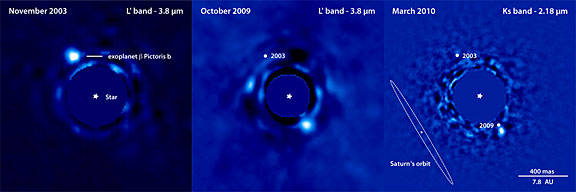New observations of the giant planet orbiting Beta Pictoris

Astronomy & Astrophysics publishes new high angular resolution observations of the giant planet orbiting the star B Pictoris. Located at 63.4 light-years from the Sun, B Pic is a very young star of about 12 million years old [1], which is 75% more massive than our Sun. B Pic is well known for harboring an extended and structured circumstellar disk. It was actually the first star to have its disk directly imaged more than 25 years ago. In 2009, a giant planet was seen orbiting within the disk. With an orbital distance of 8 to 15 astronomical units (AU), B Pictoris b is the closest exoplanet to its star that has ever been imaged. This planet offers a new opportunity to study the planetary formation processes, in particular the interactions between the planets and their native disks.
An international team of astronomers [2] observed the B Pic system, using the VLT/NaCo instrument at 2.18 m, previous observations having been made near 4 m. They detected the planet again and compared these new observations with the previous ones, as illustrated in Fig. 1. Combining all the data together shows that the planet is moving around the star, as expected from the previous data. Analyzing these new observations, the team was then able to measure the mass of the planet, around 7 to 11 times the mass of Jupiter, and its effective temperature, between 1100 and 1700*C [3].
These new data already tell us something about the formation of the planet, especially because the system is very young. The planet B Pic b is still warm, implying that it has retained most of the primordial heat acquired during its formation. If it has been formed in a similar way to the giant planets of our solar system [4], its mass and temperature cannot be explained by some evolutionary models that hypothesize a total release of the energy acquired during the accretion of disk materials.
Forthcoming observations of B Pictoris b with NaCo and also with the next generation VLT instrument SPHERE should soon provide more details about its atmosphere and orbital properties and about the way this companion influences the surrounding disk material.
Fig. 1. Multi-epoch observations of the B Pictoris b exoplanet. The planet was imaged in 2003 (left image) in the L’ band (3.8 m) in the plane of the circumstellar disk surrounding the star (not seen here). It was detected again in October 2009 (middle) when it had moved to the other side of the star. The new observations made in March 2010 at 2.18 m, which are now published in A&A, are shown in the right panel. The planet has moved yet again relative to its position measured in 2009.
[1] The B Pictoris system is much younger than our solar system formed 4.5 billion years ago.
[2] The team of astronomers includes M. Bonnefoy, A.-M. Lagrange, G. Chauvin, D. Ehrenreich, D. Mouillet (IPAG, Grenoble, France), A. Boccaletti, D. Rouan, D. Gratadour (LESIA-Observatoire de Paris, Meudon, France), D. Apai (Space Telescope Institute, Baltimore, USA), F. Allard (CRAL-ENS, Lyon, France), J.H.V Girard (ESO, Santiago, Chile), M. Kasper (ESO, Garching, Germany).
[3] The effective temperature of a planet is the surface temperature it would have if it radiated as a “black body”, that is, if it absorbed all the radiation coming from its star and re-emitted all back into space. For example, the Earth’s effective temperature is about -18*C, while its actual surface temperature is 14*C on average.
[4] The giant planets of our solar system (Jupiter, Saturn, Uranus, and Neptune) were most likely formed inside the circumstellar disk surrounding the Sun from embryos of solid material (ice, silicates) that swallowed surrounding gases from the disk.
High angular resolution detection of B Pictoris b at 2.18 m, by M. Bonnefoy, A.-M. Lagrange, A. Boccaletti, G. Chauvin, D. Apai, F. Allard, D. Ehrenreich, J. H. V. Girard, D. Mouillet, D. Rouan, D. Gratadour, and M. Kasper.
Based on “High angular resolution detection of B Pictoris b at 2.18m“, by M. Bonnefoy et al.
Published in Astronomy & Astrophysics, 2011, vol. 528, L15
Published in Astronomy & Astrophysics, 2011, vol. 528, L15









